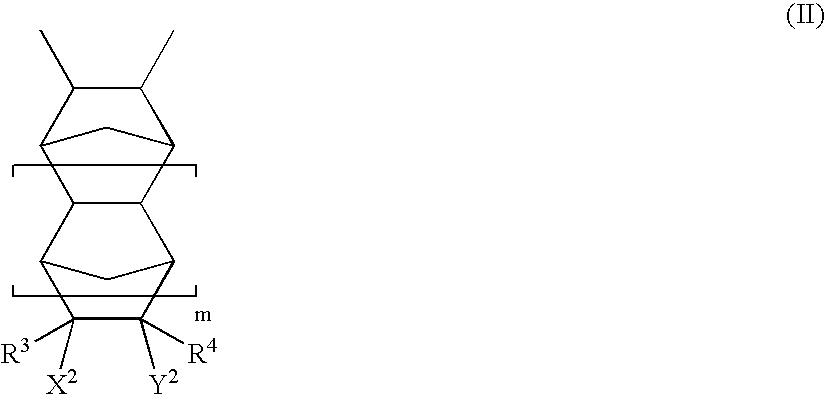Cyclic olefin resin film, polarizing plate, and liquid crystal display
a technology of cyclic olefin and resin film, applied in the field of cyclic olefin resin film, can solve the problems of polarization degree, less reliable, and noticeable changes in light transmittance of polarizing plate, and achieve the effects of improving yield and process freedom, moderate moisture permeability, and high adhesion
- Summary
- Abstract
- Description
- Claims
- Application Information
AI Technical Summary
Benefits of technology
Problems solved by technology
Method used
Image
Examples
synthesis example 1
Synthesis of Cyclic Polyolefin P-1
[0288]In a reaction vessel were put 180 parts of purified toluene and 100 parts of norbornene-5-methanol acetate. To the mixture were added a solution of 0.04 parts of acetylacetonatopalladium (II) in 80 parts of toluene, 0.04 parts of tricyclohexylphosphine, and 0.20 parts of dimethylaluminum tetrakis(pentafluorophenyl)borate. The mixture was allowed to react at 90° C. for 18 hours while stirring. After completion of the reaction, the reaction mixture was poured into excess ethanol to precipitate the polymer produced, which was collected, purified, and dried in vacuo at 65° C. for 24 hours to yield polymer P-1.
synthesis example 2
Synthesis of Cyclic Polyolefin P-2
[0289]In a reaction vessel were put 330 parts of purified toluene, 100 parts of methyl norbornenecarboxylate, and 98 parts of butylnorbornene. To the mixture were added a solution of 0.04 parts of acetylacetonatopalladium (II), 0.04 parts of tricyclohexylphosphine, and a solution of 0.2 parts of dimethylaluminum tetrakis(pentafluorophenyl)borate in 25 parts of methylene chloride. The mixture was allowed to react at 90° C. for 18 hours while stirring. After completion of the reaction, the reaction mixture was poured into excess ethanol to precipitate the polymer produced, which was collected, purified, and dried in vacuo at 65° C. for 24 hours to give polymer P-2.
synthesis example 3
Synthesis of Cyclic Polyolefin P-3
[0290]In a reaction vessel were put 220 parts of purified toluene, 100 parts of methyl norbornenecarboxylate, and 27 parts of norbornene. To the mixture were added a solution of 0.03 parts of acetylacetonatopalladium (II) in 30 parts of toluene, 0.04 parts of tricyclohexylphosphine, and a solution of 0.15 parts of dimethylaluminum tetrakis(pentafluorophenyl)borate in 12 parts of methylene chloride. The mixture was allowed to react at 90° C. for 18 hours while stirring. After completion of the reaction, the reaction mixture was poured into excess ethanol to precipitate the polymer produced, which was collected, purified, and dried in vacuo at 65° C. for 24 hours to give polymer P-3.
PUM
| Property | Measurement | Unit |
|---|---|---|
| Length | aaaaa | aaaaa |
| Fraction | aaaaa | aaaaa |
| Percent by mass | aaaaa | aaaaa |
Abstract
Description
Claims
Application Information
 Login to View More
Login to View More - R&D
- Intellectual Property
- Life Sciences
- Materials
- Tech Scout
- Unparalleled Data Quality
- Higher Quality Content
- 60% Fewer Hallucinations
Browse by: Latest US Patents, China's latest patents, Technical Efficacy Thesaurus, Application Domain, Technology Topic, Popular Technical Reports.
© 2025 PatSnap. All rights reserved.Legal|Privacy policy|Modern Slavery Act Transparency Statement|Sitemap|About US| Contact US: help@patsnap.com



